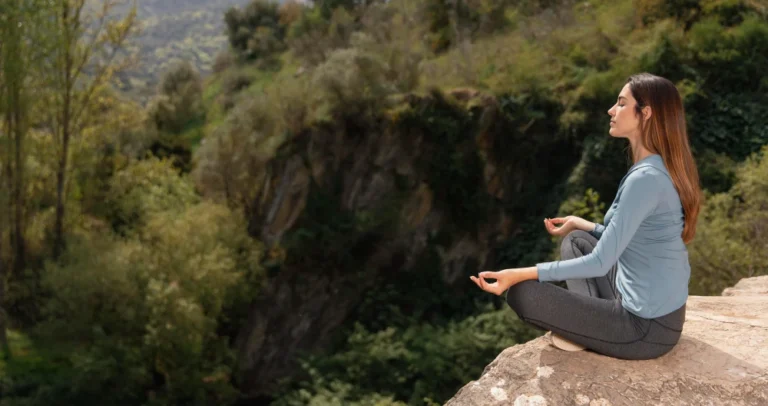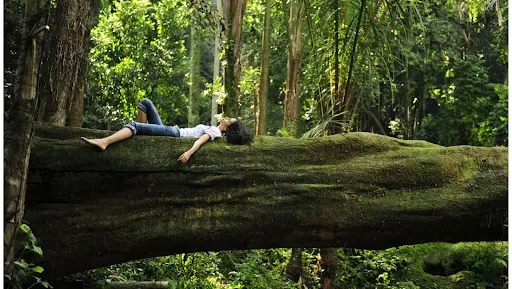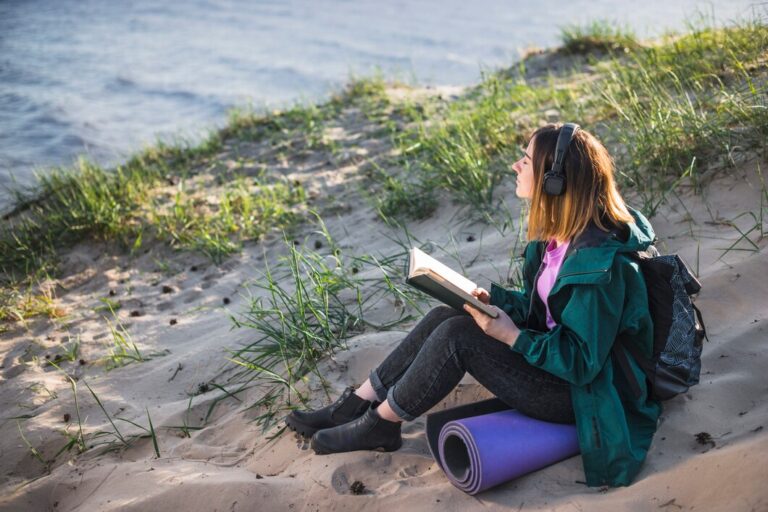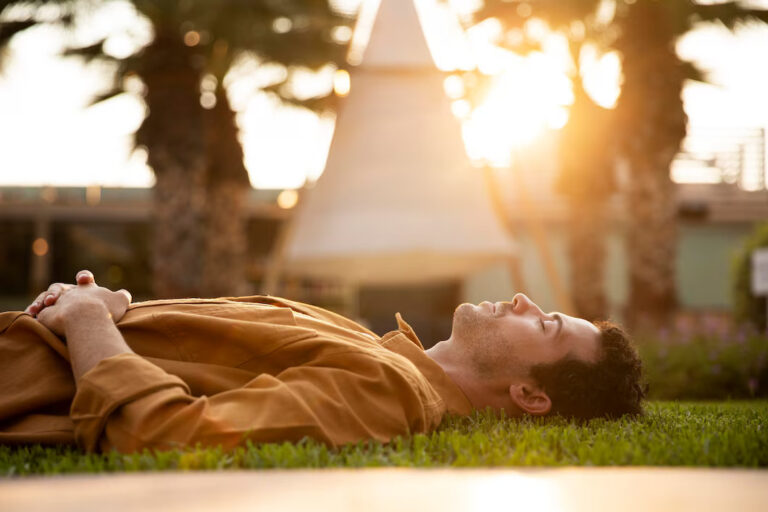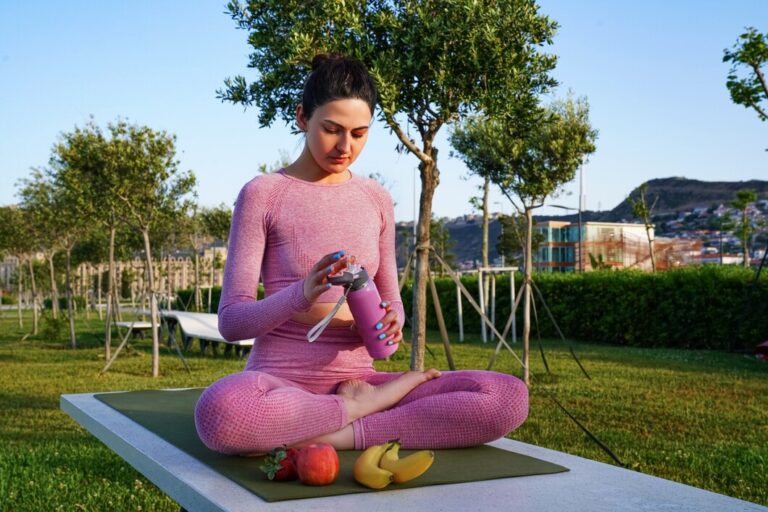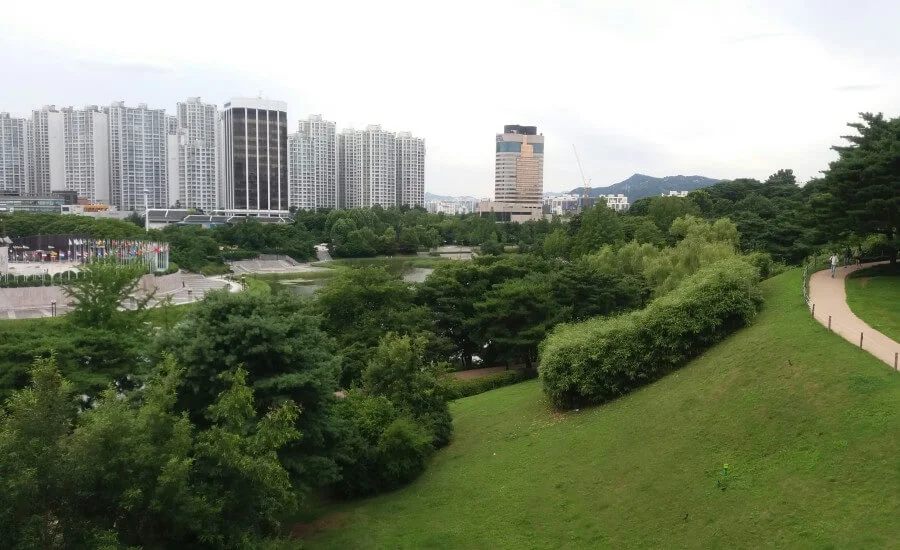
The cacophony of horns, the relentless rush of crowds, the overwhelming visual stimuli of towering buildings and flashing advertisements – exploring a busy city can often feel like an assault on the senses. We travel to experience the vibrancy and culture, yet sometimes find ourselves feeling more stressed and depleted than inspired, longing for an escape from the escape. But what if inner peace isn’t solely found in remote nature retreats or silent monasteries? What if the bustling city itself could become a training ground for presence, a place to find stillness within the chaos?
This guide explores the seemingly paradoxical idea of Embrace Zen: Achieving Inner Peace and Balance. It’s about applying principles of mindfulness and simplicity not to escape the city, but to engage with it differently – with awareness, intention, and an open heart.
We’ll delve into how to cultivate a “Zen mind” amidst the urban sprawl, discover hidden sanctuaries of quiet, practice mindful observation, navigate digital distractions, and ultimately find that your inner sanctuary is portable, available even on the busiest street corner. This journey emphasizes disconnecting from the unnecessary digital noise to connect more deeply with the real, tangible experience of the city.
Discover Finding Zen: A Path to Deep Inner Peace and Balance

Cities are, by definition, centers of energy, activity, and often, stress. The constant sensory input, the fast pace, and the sheer number of people can easily trigger feelings of overwhelm, anxiety, or disconnection. Noise pollution alone is a significant factor impacting well-being in urban environments.
We might find ourselves rushing from one sight to the next, checking our phones constantly for directions or validation, and feeling more like we’re consuming the city than truly experiencing it.
Yet, this very chaos presents a unique opportunity for mindfulness practice. Zen philosophy, at its heart, isn’t about seeking perfect external conditions but about cultivating inner stability regardless of outer circumstances. A busy city, with its constant stream of potential distractions and emotional triggers, becomes a powerful, real-world environment to practice:
- Maintaining focus amidst distraction.
- Observing thoughts and reactions without judgment.
- Finding moments of stillness in noise.
- Cultivating compassion for ourselves and others in crowded spaces.
- Appreciating beauty in unexpected places.
Instead of fighting the city’s energy, we can learn to navigate it with a centered awareness, transforming potential stressors into opportunities for mindful presence. The goal isn’t to block out the city, but to engage with it from a place of inner calm.
Zen Mind, City Heart: Applying Ancient Principles to Modern Streets

While you don’t need to become a Zen master, incorporating some core principles inspired by Zen Buddhism can profoundly shift your experience of urban travel. These principles emphasize simplicity, presence, and direct experience.
- Mindfulness (Present Moment Awareness): The foundation. Consciously bring your attention to the here and now – what you are seeing, hearing, feeling, smelling, tasting – without judgment. Let go of ruminating about the past or worrying about the future schedule.
- Non-Judgment: Observe your thoughts, feelings, and surroundings without labeling them as ‘good’ or ‘bad,’ ‘right’ or ‘wrong’. Notice the traffic noise without automatically tensing up against it. Observe a crowded street without immediately feeling overwhelmed.
- Simplicity (Kanso): Seek simplicity in your approach. Don’t try to cram too much into your itinerary. Focus on quality over quantity. Appreciate simple details – the texture of a stone wall, the shape of a window, the taste of street food. Resist unnecessary clutter, both physical and mental.
- Acceptance: Accept the reality of the urban environment – the noise, the crowds, the imperfections – without constant resistance. Fighting reality creates suffering; acceptance allows for peace within it. This doesn’t mean liking everything, but acknowledging it is as it is.
- Beginner’s Mind: Approach familiar city sights or experiences as if seeing them for the first time, with curiosity and openness, shedding preconceived notions.
Applying these principles encourages a shift from reactive stress to responsive awareness, allowing you to find pockets of peace even on the busiest streets.
Finding Your Urban Sanctuary: Seeking Quiet Oases

Even the most chaotic cities have hidden pockets of tranquility waiting to be discovered. Actively seeking out these quiet spaces provides crucial moments for respite, reflection, and recharging your ‘presence battery’.
- City Parks & Gardens: Obvious but essential. Larger parks often have quieter, less-trafficked corners. Seek out botanical gardens, small neighborhood squares, or even well-maintained cemeteries for peaceful greenery. In Vadodara, for example, Sayaji Baug (Kamati Baug) offers expansive green space, including a zoo and museum, but also potentially quieter corners for a mindful pause. Look for smaller gardens like Akota Garden or check out botanical collections.
- Libraries & Bookstores: These havens of quiet offer not just books but a calm atmosphere perfect for escaping the city buzz. Find a comfortable chair and simply sit, read, or journal.
- Museums & Art Galleries (Mid-Week/Off-Peak): While potentially busy, museum galleries, especially those displaying serene art or historical artifacts, can offer moments of quiet contemplation. Visiting during less crowded times enhances the experience. Seek out less popular exhibits or quiet seating areas.
- Places of Worship: Regardless of your personal beliefs, temples, churches, mosques, gurdwaras, or synagogues often provide publicly accessible spaces designed for quiet reflection and reverence. Be sure to observe visitor etiquette and dress codes respectfully. Vadodara, like many Indian cities, has numerous temples that might offer a quiet corner for respectful observation.
- Quiet Cafes (Off-Hours): Find a small cafe during non-peak hours. Order a simple drink, put away your phone, and just watch the world go by outside the window or observe the cafe’s atmosphere.
- Waterside Spaces: Riverbanks, canalsides, or lakeside paths within a city can offer a sense of calm and openness. The presence of water often has a soothing effect. In Vadodara, finding a peaceful spot along the Vishwamitri River (observing from a safe and clean location) could offer such a moment.
Actively searching for these urban sanctuaries becomes a mindful practice in itself – seeking stillness amidst movement.
Mindful Sightseeing & Exploration: Seeing the City Anew

Mindfulness can transform sightseeing from a frantic checklist exercise into a rich, immersive experience. It’s about slowing down and truly seeing rather than just looking.
- Engage All Senses: Consciously tune into the sensory landscape. What are the specific sounds of this street (beyond just ‘noise’)? What are the smells (food vendors, exhaust, rain)? What textures can you see in the buildings or pavement? How does the air feel on your skin?
- Mindful Walking: Walk through the city at a slower pace than usual. Feel your feet connecting with the ground. Notice the rhythm of your breath. Look up, look down, look around – observe details you’d normally rush past.
- Focus on Details: Instead of just glancing at a famous landmark, spend time observing its specific details – the craftsmanship, the effects of weather and time, the way light hits it. Appreciate the small elements that make up the whole.
- Mindful People-Watching: Find a bench or cafe seat and simply observe the flow of human life without judgment or creating elaborate stories. Notice expressions, interactions, gaits. See the shared humanity in the crowd.
- Single-Task Your Exploration: When visiting a museum, focus solely on the art. When walking, focus on walking and observing. Resist the urge to simultaneously check maps, plan the next stop, and listen to music. Choose one focus.
- Embrace Getting Slightly Lost: Put away the GPS for a short while in a safe neighborhood. Wander down interesting side streets. Allow for serendipitous discoveries. Use a physical map if needed for general orientation.
This mindful approach turns the entire city into a potential object of meditation, revealing beauty and interest in unexpected places.
Unplugging in the Metropolis: Creating Calm Amidst Connectivity

Finding Zen in the city often requires consciously creating boundaries with the very technology that contributes to its frantic pace. While tech can be useful for navigation or information, intentional unplugging creates vital space for presence.
Why Disconnect in the City?
- Reduces Sensory Overload: Silencing notifications removes a significant layer of constant stimuli competing for your attention.
- Encourages Direct Engagement: Without a screen to mediate, you engage more directly with your physical surroundings and the people you’re with.
- Fosters Inner Quiet: Creates mental space for your own thoughts and feelings to surface without interruption, allowing for deeper self-reflection even amidst external noise.
- Improves Observation: You simply notice more when you’re not looking down at a device.
- Breaks Compulsive Habits: Intentionally leaving your phone in your pocket or bag helps break the habit of mindless checking and scrolling.
Practical Unplugging Tips:
- Notification Management: Turn off all non-essential notifications. Schedule specific, brief times to check messages or emails, rather than reacting instantly.
- Designated Tech-Free Times/Zones: Commit to putting your phone away during meals, while visiting a park or museum, or for the first/last hour of your day.
- Purposeful Use Only: Use your phone as a tool (e.g., map check, quick info lookup), then put it away again. Avoid aimless browsing.
- Carry Analog Alternatives: Have a small notebook and pen for jotting notes or observations. Carry a physical book or city map.
- Embrace Airplane Mode: Use it strategically during exploration periods to prevent incoming distractions while still allowing access to offline maps or notes if needed.
Creating pockets of digital silence, even within a bustling city, is crucial for cultivating inner calm and presence.
Zen: Finding Inner Peace in Busy Urban Destinations

Ultimately, Zen: Finding Inner Peace in Busy Urban Destinations is not about transforming the city itself, but about transforming your relationship to it. It’s about realizing that inner peace is not solely dependent on external quietude but can be cultivated anywhere through mindful awareness, acceptance, and intentional practices.
By applying principles like presence, non-judgment, and simplicity, you can learn to navigate the urban landscape with less stress and greater appreciation.
This journey involves actively seeking out pockets of calm – parks like Sayaji Baug in Vadodara, quiet museum corners, riverside benches – but also finding stillness within the movement. It means engaging your senses fully, challenging the inner critic triggered by comparison or overwhelm, and consciously disconnecting from digital noise to reconnect with the tangible reality around you.
It’s about discovering the intricate beauty in architectural details, the quiet dignity in ancient temples nestled amidst modern buildings, the shared humanity in a crowded market, and the simple joy of a mindful cup of tea in a bustling cafe. The city, with all its energy and complexity, can become your unlikely Zen master, teaching you presence and resilience if you approach it with an open, mindful heart.
Common Concerns & Solutions for Finding Urban Zen

Trying to find peace in a typically stressful environment can seem counterintuitive.
Concern 1: “Cities are just too noisy and overwhelming for me to relax.”
- Solution: Acknowledge the noise, but practice observing it without resistance. Use mindfulness to notice the space between sounds. Actively seek out quieter spaces (parks, libraries. Use noise-canceling headphones occasionally for respite, but also practice accepting the soundscape as part of the experience. Focus on inner quiet through breath work.
Concern 2: “It’s hard to find genuinely quiet places in a big city.”
- Solution: Redefine ‘quiet’. It might not be absolute silence, but relative calm. Look for urban oases: botanical gardens, churchyards, museum galleries during off-peak times, university campuses, quiet side streets, riverside walkways, even specific ‘quiet zones’ designed in some modern parks. Be observant – quiet spots are often hidden in plain sight.
Concern 3: “How can I be mindful or feel peaceful when surrounded by huge crowds?”
- Solution: Practice grounding yourself through your breath or bodily sensations (feet on the ground). Focus on mindful observation – notice the crowd as a flowing entity rather than individual threats. Practice compassion – recognize everyone is just trying to navigate their day. Find small anchors of stillness – a particular building, a patch of sky. You can create inner space even amidst external bustle.
Concern 4: “Isn’t applying ‘Zen’ to city travel just a superficial trend? Is it authentic?”
- Solution: Focus on the core principles – mindfulness, presence, non-judgment, simplicity – rather than rigid dogma. These are universal tools for well-being applicable anywhere. It’s authentic if you genuinely engage in the practice of finding inner calm and mindful awareness within your urban experience, regardless of labels.
Mindful Urban Exploration Checklist

Prepare for a more peaceful and present city adventure:
- Set Intention for Presence: Decide beforehand to prioritize awareness and mindful observation over rushing or digital distraction.
- Identify Potential Sanctuaries: Research quiet parks, gardens, libraries, museums, or peaceful cafes in the areas you’ll visit (e.g., lookup parks in Vadodara like Sayaji Baug).
- Pack Analog Tools: Small notebook & pen, physical book, perhaps a basic city map.
- Comfortable Shoes: Essential for mindful walking and exploring on foot.
- Plan Loose Itinerary: Allow space for spontaneous discoveries and moments of rest; avoid over-scheduling.
- Tech Boundaries: Decide on your notification settings and plan for tech-free periods during the day. Download offline maps if needed.
- Mindfulness Reminders: Set subtle reminders (a pebble in your pocket, a specific bracelet) to prompt you to return to the present moment throughout the day.
- Pack Curiosity & Non-Judgment: Be open to seeing the city and your reactions to it with fresh, accepting eyes.
Your Inner Sanctuary is Portable

The noise and rush of urban life can easily pull us out of ourselves, leaving us feeling stressed, drained, and disconnected. But the true sanctuary, the source of genuine peace, resides not in escaping the world, but within our own awareness.
Finding Zen in busy urban life teaches us that this inner sanctuary is portable; we can access calm, presence, and appreciation anywhere, anytime, by consciously choosing where we place our attention.
By embracing mindfulness, seeking moments of quiet, engaging our senses fully, and setting healthy boundaries with digital distractions, we transform our relationship with the city. It shifts from an overwhelming adversary to a complex, fascinating landscape for practicing presence.
You now have the principles and techniques to begin this practice. You don’t need a remote mountain or a silent retreat to find peace – you only need to bring your attention home to the present moment, right where you are.
What small patch of stillness can you find in your urban environment today? How can you engage one sense more fully on your next walk through the city? Start with these small invitations to presence. Cultivate your inner calm, and you’ll discover you carry your peace with you, a quiet center resilient even amidst the vibrant chaos of the city.
Tech-Free Activity Guide (Urban Zen: Mindful Activities for City Explorers)

Discover peace and presence in the city with these tech-free, mindful activities:
- Mindful Walking / Urban Hiking: Choose a neighborhood and walk slowly without headphones. Pay attention to: the feeling of your feet on different pavements, the sounds (individual sounds within the overall noise), the smells (bakeries, exhaust, plants), the architectural details, the way light hits buildings.
- Park Bench Meditation: Find a bench in a city park (like Sayaji Baug or Akota Garden in Vadodara). Sit comfortably, close your eyes or soften your gaze, and focus on your breath for 5-15 minutes. Notice sounds or sensations without judgment, gently returning focus to your breath.
- Sensory Cafe Visit: Choose a cafe, preferably with a window view. Order a drink. Put your phone away. Mindfully savor the drink – notice its temperature, taste, aroma. Observe the life passing outside the window or the atmosphere inside the cafe without judgment.
- Museum/Gallery Slow Look: Visit a museum or art gallery. Instead of trying to see everything, choose just one room or even one piece of art. Spend 10-20 minutes simply observing it in detail. Notice colors, textures, shapes, emotions evoked. Let your eyes wander over it slowly.
- Architectural Sketching/Journaling: Sit in a square or street with interesting buildings. Use a notebook and pen/pencil to sketch a small detail – a doorway, a window, a pattern. Or, journal descriptive observations about the architecture and atmosphere. Focus on looking closely.
- Mindful People-Watching: Find a comfortable spot where you can observe people passing by (a plaza, park entrance). Watch with gentle curiosity, noticing gaits, expressions, interactions, without creating stories or judgments. Observe the flow of humanity.
- Library Quiet Time: Spend 30 minutes in the quiet section of a public library. Browse shelves slowly, read a physical book or magazine, or simply sit and absorb the peaceful, studious atmosphere.
Urban Nature Observation: Find a small patch of nature – a tree on the sidewalk, a planter box, a fountain. Observe it closely. Notice the texture of bark, the shape of leaves, the way water moves, any insects or birds interacting with it.
